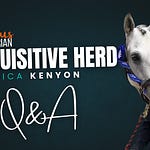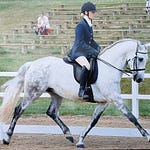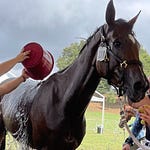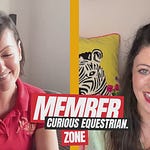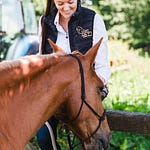If you've ever felt apprehensive about going out hacking with your horse, or found yourself struggling to maintain control during an outdoor ride, you're not alone. Horse riding confidence is a crucial ingredient for a safe and enjoyable hacking experience, yet it can sometimes feel elusive. Fortunately, with the right mindset, preparation, and training approach, you can cultivate a calm, connected partnership with your horse, even in the face of unpredictable environments.
Drawing on years of experience in natural horsemanship and eventing, Hannah Walton, a horse development specialist and event rider based in Oxfordshire, shares invaluable insights into how to build that confidence and create a horse that's not only physically capable but mentally ready for hacking adventures. Here, we explore her expert tips and holistic approach to horse training that focuses on the horse's mindset as much as their body, and how that translates to safer, more enjoyable rides for both horse and rider.
Not yet part of our Inquisitive Herd? Above you'll find a 1-minute preview of our conversation with Annabelle Holmes. Join our community today to watch the complete interview ad-free and access our library of exclusive content on sustainable horse care.
Or watch free with ads on our YouTube Channel
From Bolting to Bravery: Hannah's Journey to Horse Riding Confidence
Hannah's personal journey into horsemanship began with a horse that challenged her limits: a bolting ex-racehorse she got when she was just fourteen. Instead of rushing into eventing as she had dreamed, she chose to prioritise her horse's readiness and mindset. This decision sparked a twenty-year detour into horsemanship that shaped her unique approach, one deeply rooted in empathy, patience, and education.
She recalls that her first horse was not ready for the excitement and demands of eventing, and she didn't want to push her into something she wasn't prepared for. This mindset of "doing it with the horse, not to the horse" became a cornerstone of her philosophy.
Over the years, Hannah trained with some of the most respected names in the field, including Monty Roberts and Pat and Linda Parelli. These experiences helped her develop methods that blend natural horsemanship with classical disciplines, focusing on creating a calm, confident horse that is mentally and physically prepared for any challenge.
Why Mindset Matters as Much as Physical Training
When it comes to horse riding confidence, many riders focus heavily on the physical skills, training the horse's body to respond to aids and commands. But Hannah emphasises that training the mind is just as critical. Horses are prey animals with strong instincts to freeze, flee, or fight when they feel threatened. Without a solid mental foundation, even the most physically trained horse can become overwhelmed and reactive.
"It's as important to train the mind as it is to train the body," Hannah explains. She observes that in some natural horsemanship circles, the body can be neglected, while in traditional riding, the mind is sometimes overlooked. Her approach seeks to balance both aspects, ensuring the horse understands the aids, can process environmental stimuli calmly, and has strategies to manage tension.
Hacking, in particular, is a perfect test of this mental foundation. It requires the horse to navigate unpredictable environments, busy roads, sudden noises, wildlife, and other horses, while remaining relaxed and responsive. Hannah points out that a horse with a good foundation can be "put in a box like a taxi" without getting stressed, tied up safely, and ridden out calmly next to a buddy without spooking or pulling.
Creating the "Perfect All-Rounder" Horse
Hannah's vision is to develop horses that are versatile, confident, and calm in all situations. She calls this the "perfect all-rounder." Such a horse can:
Travel quietly in a trailer without stress
Be tied up calmly in unfamiliar environments
Accept tack and human touch with ease
Go out hacking with confidence, even alongside other horses or in new surroundings
Respond appropriately to unexpected stimuli like noises, movement, or changes in terrain
Importantly, Hannah challenges the misconception that horses with these qualities are just "lucky." Instead, she stresses that these horses can be created through consistent education, patience, and mindset-focused training.
For example, if a horse is worried about noise, Hannah doesn't advocate overwhelming them with every possible scary sound at once. Instead, she suggests a gradual, simulated exposure paired with positive reinforcement, asking the horse to accept the noise, then releasing pressure when they show curiosity or relaxation. This method helps the horse learn new coping strategies rather than resorting to flight or freeze responses.
Preparation and Setup: Keys to Successful Hacking
Confidence on the hack doesn't come from luck—it's about careful preparation and thoughtful setup. Hannah breaks this down into two parts:
1. The Setup: Choosing the Right Environment and Company
Not every ride or riding partner is suitable for every horse. Hannah advises riders to consider:
Who they ride with — avoiding companions who might push the horse beyond its confidence level
The route — avoiding high-traffic or unpredictable areas if the horse is still building confidence
Timing — choosing quieter times of day to reduce traffic, noise, and distractions
Weather and conditions — being cautious on windy days or when the environment might provoke tension
When leading group rides or hacking camps, Hannah carefully plans who rides together, ensuring that horses and riders of similar confidence levels support each other and that no one gets left behind. She emphasises the importance of staying together as a "herd" and working collectively to build confidence.
2. The Preparation: Building Skills Step-by-Step
Hannah likens hacking to a big exam with many challenges. To ensure success, riders should break down those challenges and prepare their horses for each one in controlled settings before facing them on the trail. This might include:
Teaching the horse to accept and remain calm around noise, movement, and unexpected stimuli
Practising tight squeezes, stops, and stands still on cue
Groundwork exercises to build connection and relaxation
Gradually expanding the horse's comfort zone from arena to paddock to trail
Hannah stresses that if a horse is tense or rushing when being led in from the field, this likely translates to similar behaviour when hacking. Preparation work at home is essential to build a foundation of relaxation and responsiveness.
Handling the Unexpected: Strategies for Real-Life Situations
One of the biggest challenges riders face is dealing with sudden, unpredictable events during a hack: pheasants flying out of bushes, dogs off lead chasing horses, or loud noises startling your mount. Hannah acknowledges that it's impossible to recreate every scenario in training, but you can simulate pressure situations to help your horse learn to manage stress calmly.
For instance, she might introduce flags, plastic bags, or noisy equipment in a controlled environment, always stopping the stimulus as soon as the horse shows calmness or curiosity. The goal is not to overwhelm but to teach the horse to tolerate low levels of pressure without escalating to fear or flight.
Recognising subtle signs of tension is critical. Hannah points out that horses communicate their discomfort through changes in posture, facial expression, and behaviour long before they spook or bolt. Riders who tune in early can "empty the cup" of stress before it overflows into a major reaction.
She shares a story from Warwick Schiller about "trigger stacking," a phenomenon where repeated minor stressors accumulate until the horse reaches a breaking point. For example, a horse that is fine with one rabbit might become overwhelmed after seeing several in quick succession, leading to a sudden flight response. By noticing early signs of tension, riders can intervene before the horse hits that red zone.
The Human Factor: Managing Our Own Mindset
Hannah highlights that horses are incredibly sensitive to their riders' energy and emotions. Studies show that even a rider's increased heart rate or anxiety can cause a horse to spook, even if the external stimulus remains unchanged.
Therefore, building horse riding confidence also means managing our own mindset. Hannah encourages riders to ground themselves through meditation, breathwork, and mindfulness to create a calm, focused presence that reassures their horse.
She also advocates for self-compassion. Fear and nervousness are natural, especially after a bad experience. Riders should acknowledge their feelings rather than dismissing or suppressing them, and progress at a pace that feels safe for both horse and rider.
It's Okay to Get Off: Redefining Success in Horse Riding
One of the most powerful messages Hannah shares is that getting off your horse during a hack is not a failure; in fact, it can be a vital part of the training process.
She recounts working with a large, athletic horse who required multiple dismounts during a fifteen-minute hack to help him release tension safely. Over several rides, the number of times Hannah needed to get off decreased until the horse was calm, connected, and confident enough for an entire ride without dismounting.
This approach challenges the ingrained equestrian belief that riders must "stay in the saddle at all costs." Instead, Hannah encourages riders to prioritise their horse's mental wellbeing and their own ability to help the horse, even if that means working from the ground.
Getting off to reset, calm, and reconnect can build trust and confidence far more effectively than pushing through fear or tension. It's about progress, not perfection.
Applying These Principles Across All Disciplines
While hacking provides a clear example of how mindset and preparation affect horse riding confidence, these principles apply to all equestrian disciplines. Whether you're training a young horse, competing in dressage, show jumping, or eventing, the foundation is the same:
Teach your horse to understand and respond calmly to aids
Build connection and communication based on trust
Prepare the horse mentally for unexpected stimuli and pressure
Develop strategies for relaxation and tension release
Manage your own mindset to remain calm and present
By integrating mind and body training, you create a well-rounded horse capable of handling the challenges of any discipline or environment.
Getting Started: Where to Find Support and Training
If you're inspired to build your horse riding confidence and create a stress-free hacking experience, Hannah offers specialised hacking clinics designed to help riders and horses develop the skills and mindset needed for success.
These clinics focus on small groups with personalised instruction to address individual challenges. Horses stay at Hannah's training barn, giving riders a break from chores while immersing themselves in focused training.
The next hacking clinic is typically held in March, with preparation work encouraged over the winter months. You can connect with Hannah through her website hannawalton.co.uk or on social media under Hannah Walton Equestrian.
Final Thoughts: Building Confidence One Step at a Time
"You only are gonna get on to whatever step of the mountain block that you or whatever place you get to might even be at the mountain block, but it might be just just putting that foot up in that first step. And if that's the point where your brain goes, oh my god, I'm not gonna be okay, this is gonna happen, and you start doing the whole story that might happen in your mind, then you stay at that point and you talk through the story and then you wait and you breathe and you just be there and you don't go past the next stage." – Hannah Walton
Building horse riding confidence is a journey, one that requires patience, empathy, and a willingness to learn alongside your horse. It's about tuning in to your horse's mental state as much as their physical readiness, creating a partnership based on trust and understanding.
Whether you're tackling your first hack or aiming to refine your eventing skills, remember that success isn't about rushing or forcing progress. It's about steady, mindful steps that honor both you and your horse's needs. And sometimes, the bravest thing you can do is simply get off, breathe, and try again.
With the right approach, you can transform hacking from a stressful challenge into a joyful, confidence-building experience that deepens your connection with your horse and enriches your riding life.
Thank you for being part of our Inquisitive Herd! We appreciate your support that allows us to create ad-free content like our interview with Annabelle Holmes. As a member, you can enjoy the full episode without interruptions and access our exclusive playlist of member-only extended interviews and bonus content.




